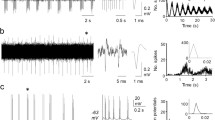Summary
Afterhyperpolarization (AHP) following single or short trains of spikes in rubrospinal neurones (RN neurones) of the cat has been studied with intracellular recording techniques. The AHP amplitude was potential dependent; it increased with depolarization and decreased with hyperpolarization and had an extrapolated reversal potential about 20 mV below resting membrane potential. The AHP was associated with an increase in the membrane conductance and it was concluded that the AHP is primarily caused by an increase in membrane conductance to potassium ions. The time course of the conductance change underlying the AHP was measured with short current pulses and calculated from the AHP voltage. The AHP following a single spike was conditioned at different interspike intervals by a preceding spike (or several spikes). In many RN neurones the AHP (conductance) following a spike added approximately linear to that generated by a preceding spike. In most cells, however, the AHP following a spike was instead depressed by a preceding spike. The summation of AHPs increased progressively, while the depression appeared to be already maximal with one preceding spike. The depression was then approximately constant for interspike intervals less than the AHP duration. It will be shown in a following paper that these properties of the AHP are reflected in the behaviour of the repetitive discharge evoked by constant current pulses in the same neurones.
Similar content being viewed by others
References
Baker R, Precht W (1972) Electrophysiological properties of trochlear motoneurons as revealed by IVth nerve stimulation. Exp Brain Res 14: 127–157
Baldissera F, Gustafsson B (1974a) Afterhyperpolarization conductance time course in lumbar motoneurones of the cat. Acta Physiol Scand 91: 512–527
Baldissera F, Gustafsson B (1974b) Firing behaviour of a neuronemodel based on the afterhyperpolarization conductance time course. First interval firing. Acta Physiol Scand 91: 528–544
Baldissera F, Gustafsson B (1974c) Firing behaviour of a neurone model based on the afterhyperpolarization conductance time course and algebraical summation. Adaptation and steady state firing. Acta Physiol Scand 92: 27–47
Baldissera F, Gustafsson B, Parmiggiani F (1978) Saturating summation of the afterhyperpolarization conductance in spinal motoneurones. A mechanism for secondary range repetitive firing. Brain Res 146: 69–82
Barret EF, Barret JN (1976) Separation of two voltage-sensitive potassium currents, and demonstration of a tetrodotoxinresistant calcium current in frog motoneurones. J Physiol (Lond) 255: 737–775
Coombs JS, Eccles JC, Fatt P (1955) The electrical properties of the motoneurone membrane. J Physiol (Lond) 130: 291–325
Eccles JC (1953) The neurophysiological basis of mind. The principles of neurophysiology. Clarendon Press, Oxford
Eccles JC, Eccles RM, Lundberg A (1958) The action potentials of the alpha motoneurones supplying fast and slow muscles. J Physiol (Lond) 142: 275–291
Grantyn R, Grantyn A (1978) Morphological and electrophysiological properties of cat abducens motoneurons. Exp Brain Res 31: 249–274
Gustafsson B (1979) Changes in motoneurone electrical properties following axotomy. J Physiol (Lond) 293: 197–215
Gustafsson B, Zangger P (1978) Effect of repetitive activation on the afterhyperpolarization in dorsal spinocerebellar tract neurones. J Physiol (Lond) 275: 303–319
Gustafsson B, Lindström S, Zangger P (1978a) Firing behaviour of dorsal spinocerebellar tract neurones. J Physiol (Lond) 275: 321–343
Gustafsson B, Lindström S, Takata M (1978b) Afterhyperpolarization mechanism in the dorsal spinocerebellar tract cells of the cat. J Physiol (Lond) 275: 283–301
Ito M, Oshima T (1962) Temporal summation of after-hyperpolarization following a motoneurone spike. Nature 195: 910–911
Ito M, Hongo T, Yoshida M, Okada Y, Obata K (1964) Antidromic and trans-synaptic activation of Deiters' neurones induced from the spinal cord. Jpn J Physiol 14: 638–658
Kernell D (1965a) The adaptation and the relation between discharge frequency and current strength of cat lumbosacral motoneurones stimulated by long-lasting injected currents. Acta Physiol Scand 65: 65–73
Kernell D (1965b) High-frequency repetitive firing of cat lumbosacral motoneurones stimulated by long-lasting injected currents. Acta Physiol Scand 65: 74–86
Kernell D (1965c) The limits of firing frequency in cat lumbosacral motoneurones possessing different time course of afterhyperpolarization. Acta Physiol Scand 65: 87–100
Kernell D, Sjöholm H (1973) Repetitive impulse firing: comparisons between neurone models based on ‘voltage clamp equations’ and spinal motoneurones. Acta Physiol Scand 87: 40–56
Kitai ST, Tanaka T, Tsukahara N, Yu H (1972) The facial nucleus of cat: Antidromic and synaptic activation and peripheral nerve representation. Exp Brain Res 16: 161–183
Kitai ST, Kennedy DT, Defrance JF, Hatada K (1974) Electrophysiological properties of lateral reticular nucleus cells: I. Antidromic activation. Exp Brain Res 21: 403–418
Rall W (1964) Theoretical significance of dendritic trees for neuronal input-output relations. In: RF Reiss (ed) Neural Theory and Modeling Stanford Univ Press, Stanford, pp 73–97
Schwindt PC, Calvin WH (1973) Nature of conductances underlying rhythmic firing in cat spinal motoneurons. J Neurophysiol 36: 955–973
Takahashi K (1965) Slow and fast groups of pyramidal tract cells and their respective membrane properties. J Neurophysiol 28: 908–924
Tsukahara N (1981) Synaptic plasticity in the mammalian central nervous system. Ann Rev Neurosci 4: 351–379
Tsukahara N, Murakami F, Hultborn H (1975) Electrical constants of neurons of the red nucleus. Exp Brain Res 23: 49–64
Tsukahara N, Toyama K, Kosaka K (1967) Electrical activity of red nucleus neurones investigated with intracellular microelectrodes. Exp Brain Res 4: 18–33
Author information
Authors and Affiliations
Additional information
Dr. H. Hultborn was supported by the Japan Society for the Promotion of Science.
Rights and permissions
About this article
Cite this article
Hultborn, H., Murakami, F., Tsukahara, N. et al. Afterhyperpolarization in neurones of the red nucleus. Exp Brain Res 55, 333–350 (1984). https://doi.org/10.1007/BF00237284
Received:
Issue Date:
DOI: https://doi.org/10.1007/BF00237284




